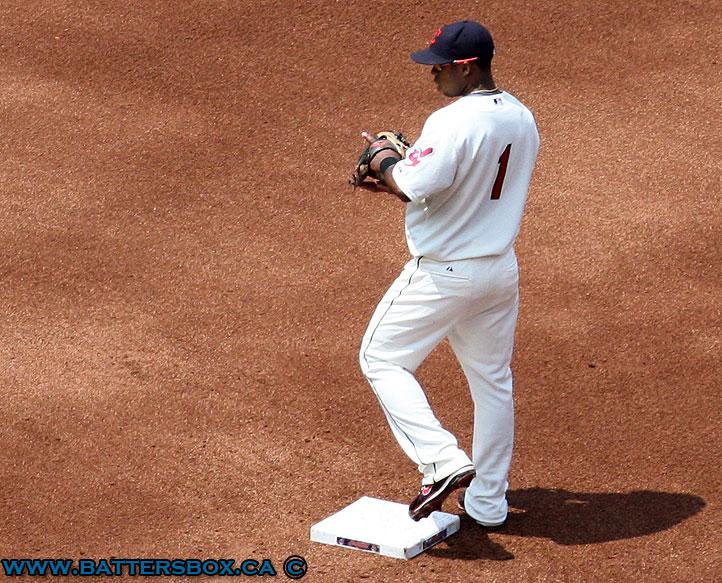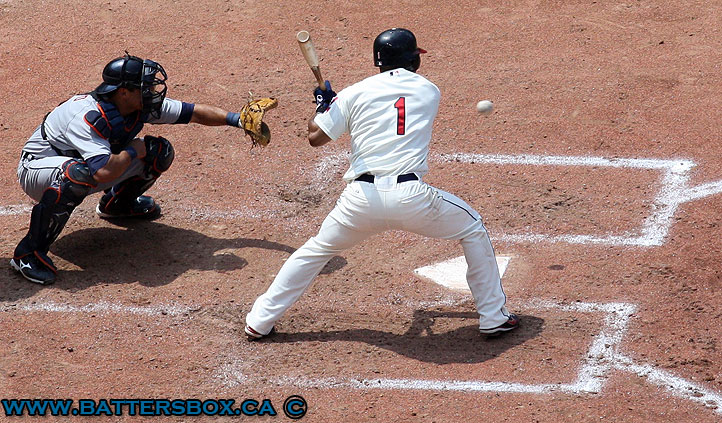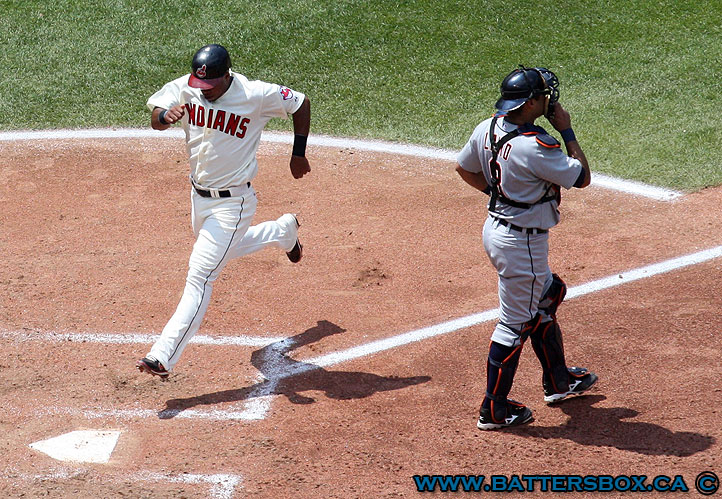
Luis Valbuena manning second base for the Cleveland Indians against the Detroit Tigers at Progressive Energy Field August 2, 2009.

Luis Valbuena takes a pitch from Detroit starter Armando Galarraga in the fourth inning.

Luis Valbuena would later single and score on a two-run double from Andy Marte as part of a five-run frame. Tigers catcher Gerald Laird can only watch. Valbuena went 2-for-5 with a double and two runs scored in the Tribe's 11-1 thrashing of the Tigers.
 Luis Valbuena has been in pro baseball for quite a while. The Venezuelan signed as a free agent with the Seattle Mariners back in 2002. The 5-foot-10 left-handed hitter made his U.S. debut in 2005 with Everett in the Northwest League and hit .261 with 12 homers, 50 runs batted in and 14 stolen bases. In 2006, Valbuena hit a combined .275 with Wisconsin and Inland Empire and stole 22 bases. He reached Double-A in 2007 but hit just .239 with 11 homers at West Tenn. Valbuena lifted his average to a combined .303 with West Tenn and Triple-A Tacoma and belted 11 homers with 60 RBI and 18 stolen bases. He made his big league debut with the M's on September 2, 2008 as a pinch-hitter but went 0-for-1 against the Rangers in Texas. His first major league hit was a single off Angels reliever Scot Shields in Anaheim September 11. Valbuena batted .245/.315/.347 with one run batted in over 54 plate appearances. Valbuena's time in Seattle came to an end in December, 2008 after he was dealt to Cleveland as part of a three-way, 11 player deal with the New York Mets that involved Franklin Gutierrez, starter Jason Vargas and reliever J.J. Putz.
Luis Valbuena has been in pro baseball for quite a while. The Venezuelan signed as a free agent with the Seattle Mariners back in 2002. The 5-foot-10 left-handed hitter made his U.S. debut in 2005 with Everett in the Northwest League and hit .261 with 12 homers, 50 runs batted in and 14 stolen bases. In 2006, Valbuena hit a combined .275 with Wisconsin and Inland Empire and stole 22 bases. He reached Double-A in 2007 but hit just .239 with 11 homers at West Tenn. Valbuena lifted his average to a combined .303 with West Tenn and Triple-A Tacoma and belted 11 homers with 60 RBI and 18 stolen bases. He made his big league debut with the M's on September 2, 2008 as a pinch-hitter but went 0-for-1 against the Rangers in Texas. His first major league hit was a single off Angels reliever Scot Shields in Anaheim September 11. Valbuena batted .245/.315/.347 with one run batted in over 54 plate appearances. Valbuena's time in Seattle came to an end in December, 2008 after he was dealt to Cleveland as part of a three-way, 11 player deal with the New York Mets that involved Franklin Gutierrez, starter Jason Vargas and reliever J.J. Putz.Valbuena began 2009 back in Triple-A with Columbus but earned a promotion in May after hitting over .300. Valbuena split time at second and short with the Tribe and belted his first major league homer against the White Sox Bartolo Colon June 7. His batting average was below the Mendoza Line in early July but he ended the year with a line of .250/.298/.416 which included 10 homers, 31 RBI and a pair of stolen bases in 103 games. Valbuena began 2010 with the Tribe but struggled by hitting just .193 in 91 contests. Last season, he played just 17 games with Cleveland as rookie Jason Kipnis took over at second base. Valbuena batted just .209 with a homer and RBI with the Indians but in Columbus, he batted at a .302 clip with 22 doubles, 17 homers, 75 RBI and three steals. Valbuena's OPS was .975 and 1.032 with Columbus over 20-plus game sample sizes in 2009 and 2010 respectively. With the glove, Valbuena has a career fielding percentage of .988 at second base but his career UZR (Ultimate Zone Rating) at second base according to FanGraphs is -9.3.
Valbuena wore #1 with the Indians until Kosuke Fukudome arrived in a trade from the Chicago Cubs last year and wound up switching to #2. He may very well be taking over for the player who ended 2011 wearing #2 in Toronto. His acquisition may be insurance for free agent second baseman Kelly Johnson. It may also provide competition for the utility infielder spot with Mike McCoy. Valbuena, who has played second, short, third and left field in the majors, will turn 26 on Wednesday (November 30).
I will always remember Valbuena for his role in helping the Jays sink the Indians in this game back in 2010. Valbuena's performance also left quite an impression on this broadcaster after the game.




